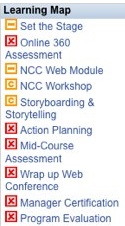In my recent workshop, an attendee shared a story that I have to pass along. He works for a company that serves a sector of the marketplace that has been core to US business, and is now in tough times. Naturally, the employees are concerned about the prospects.
The CEO is sharing, via a blog, his ongoing thoughts on dealing with the issue. Rather than puff pieces for external readers, written by a PR hack, he’s writing authentically for internal consumption about where his thinking is going and what he and the executive team are doing. He’s not making false promises, and the employee was very clear that there are no clear answers yet, but they’ve insight into how deep the thought processes have been about the situation, and how earnestly (and cleverly) they’re working on solving the issue. He’s even sharing the questions he’s considering. While all the comments aren’t visible, anyone can provide input and the CEO can react. This is powerful.
I’ve mentioned before that providing a ‘leading out loud’ record for people to follow is a great mechanism to foster virtual mentorship and share directions, and this is a really valuable way for organizations to communicate. As Rae Tanner discussed with me yesterday as we walked around DC before the start of the ASTD main conference, imagine an organization where everyone was onboarded with a real understanding of the business (we thought a game would be appropriate), and then were able to follow the ongoing thinking. Do you think they’d be better equipped to execute, and, better yet, contribute to organizational success? Certainly if it was coupled with a learning culture and rewards aligned with the desired behaviors.
The worskhop attendees easily ‘got’ the value of this scenario; that CEO knows what leadership is about, and is manifesting it in a visionary way. This is what technology can facilitate. Technology is a tool, but one that provides new affordances for communication and collaboration. The opportunities to improve things individual, organizationally, and societally are awe-inspiring. Now we need to seize the initiative and make really worthwhile things happen. Are you game?
 When I went around the room asking what people were hoping to get out of the day, a lot of mentions of LMS and elearning made me realize that the title of “elearning strategy” had perhaps misled people into thinking this was just about courses online, whereas I was going quite a ways further through my performance ecosystem. I took some time to explain that my vision of learning was far beyond courses, and included problem-solving, innovation, and more.
When I went around the room asking what people were hoping to get out of the day, a lot of mentions of LMS and elearning made me realize that the title of “elearning strategy” had perhaps misled people into thinking this was just about courses online, whereas I was going quite a ways further through my performance ecosystem. I took some time to explain that my vision of learning was far beyond courses, and included problem-solving, innovation, and more. What I like about it is it takes a longer term view of skills. The sample he showed (and of course I realize it’s presented in the best light) was a learning map for a course, but with lots of components spread out over time (sample map shown). There’s a priori assessment, content, activities with managers, etc.; a mix of activity, practice, reflection, just the sort of model we should be designing. We know spaced practice matters, with reactivation, reflection, etc. It’s also valuable to go back to the workplace, and then check-in later to see how things are going. It’s a fuller picture of what learning’s about.
What I like about it is it takes a longer term view of skills. The sample he showed (and of course I realize it’s presented in the best light) was a learning map for a course, but with lots of components spread out over time (sample map shown). There’s a priori assessment, content, activities with managers, etc.; a mix of activity, practice, reflection, just the sort of model we should be designing. We know spaced practice matters, with reactivation, reflection, etc. It’s also valuable to go back to the workplace, and then check-in later to see how things are going. It’s a fuller picture of what learning’s about. Ross reiterated the notion that the current context is a state of increasing change. Things are moving faster, and the chaotic reality underpinning our existence is being brought into highlight more and more. He talked about how commoditization is a driving economic factor, the fact that others can reproduce what you create quickly, so there’s incredible pressure to have to build more on top. I afterward asked him and he supported my contention that optimal execution is only the price of entry, and that continual innovation and delivering a seamless customer experience will be the differentiator.
Ross reiterated the notion that the current context is a state of increasing change. Things are moving faster, and the chaotic reality underpinning our existence is being brought into highlight more and more. He talked about how commoditization is a driving economic factor, the fact that others can reproduce what you create quickly, so there’s incredible pressure to have to build more on top. I afterward asked him and he supported my contention that optimal execution is only the price of entry, and that continual innovation and delivering a seamless customer experience will be the differentiator.